Cloud physics, aerosols, turbulence, and the stuff of climate inform a long career in atmospheric science
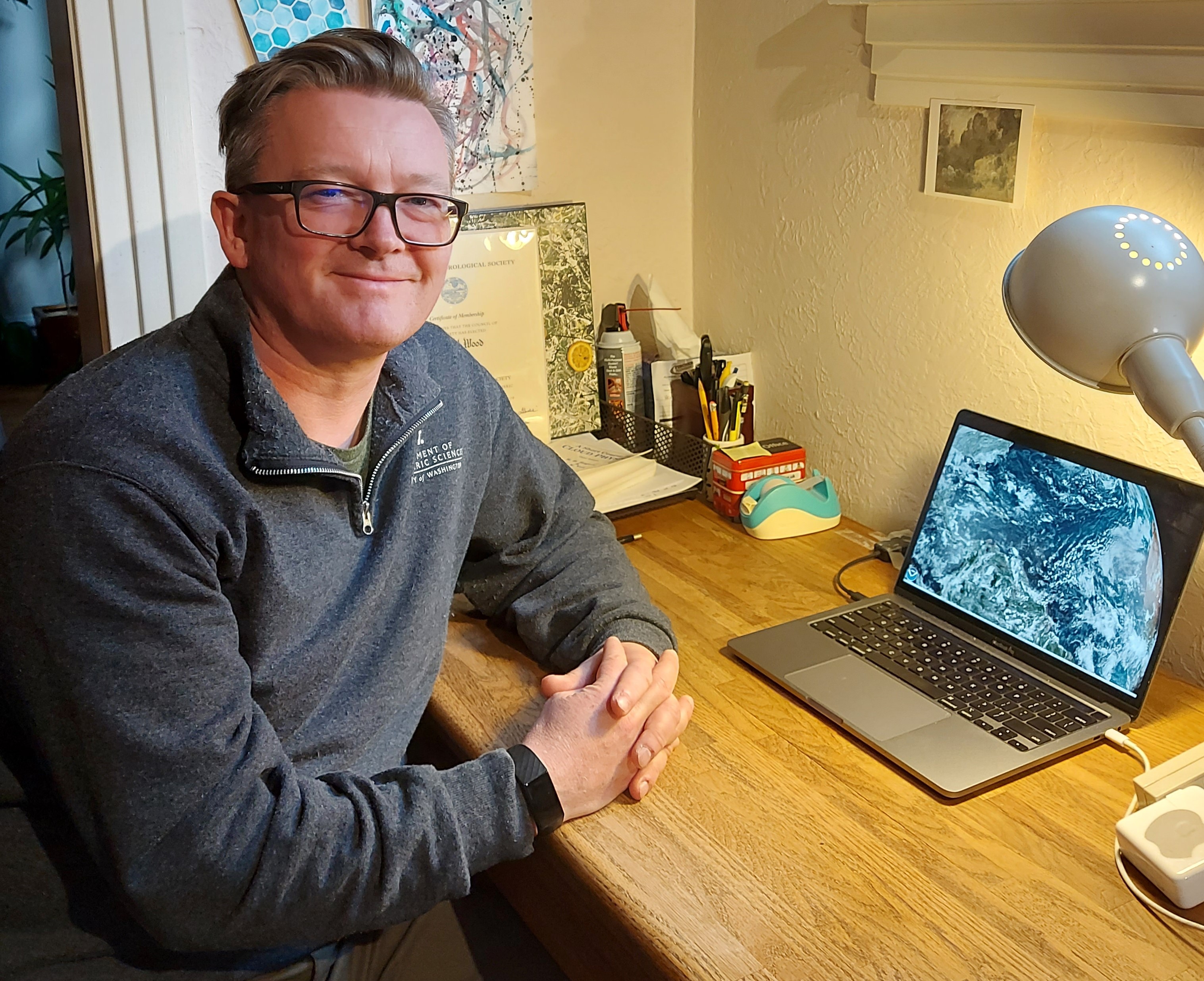
Robert “Rob” Wood, a student of clouds and their physics, is a professor of atmospheric sciences at the University of Washington.
He calls the objects of his study beautiful and complex, with processes of formation and evolution that are not fully understood. His special interest is low clouds, which are abundantly arrayed over Earth at a cloud-top height of 3 kilometers (1.8 miles) or less.
Some of Wood’s many investigations into clouds have been funded by the U.S. Department of Energy’s (DOE) Atmospheric System Research (ASR) program.
His latest ASR project, a 2020 to 2023 effort, investigates two interacting factors that maintain low clouds, but are hard to represent in earth system models: turbulent motion and aerosols―ultrafine particles suspended in the air.
Clouds shade land and ocean surfaces and modulate solar radiation. Each cloud may be visible for minutes to days, forming into an overhead puff or gathering in decks that stretch for hundreds of miles. Cloud-aerosol interactions have climate effects that are hard to understand. In part, that’s because clouds are ephemeral, microphysically complex, and often occupy rapidly evolving portions of the sky.
Wood was also principal investigator for an earlier, but related, 2015―2019 ASR project that focused on the elusive micro- and macrophysical properties of low marine clouds.
In all, Wood has been a principal investigator on three ASR projects since 2011 and took part in three others.
For more than a decade, he has also been on a long string of ASR committees related to clouds, aerosols, precipitation, and infrastructure. Most recently, from 2017 to present, Wood is co-chair of ASR’s Warm Boundary Layer Processes working group.
“I keep returning to research aircraft campaigns. They provide some key measurements that are only possible by actually being inside the clouds themselves.”
– Rob Wood
The Greatness of Graciosa
The ASR project Wood began in 2020 taps data on continental low clouds from ARM’s Southern Great Plains (SGP) atmospheric observatory in the American Midwest as well as the user facility’s relatively new Eastern North Atlantic (ENA) fixed site on Graciosa Island in the Azores.
Wood’s recent ASR projects benefit from instruments on Graciosa, a relatively flat volcanic remnant in the Azores. It is situated in a marine environment remote enough to deliver remarkably pristine measurements of low clouds.
“You don’t want the island to have too much terrain,” he says, “and you want the measurement site to be on the upwind side of the island to face key prevailing winds.”
The ASR project that began in 2015 drew data from a 2009 to 2010 field campaign on Graciosa called Clouds, Aerosol, and Precipitation in the Marine Boundary Layer (CAP-MBL). It was supported by DOE’s Atmospheric Radiation Measurement (ARM) user facility, which supplied a mobile observatory.
From 2017 to 2018, Wood was one of two principal investigators during ARM’s Aerosol and Cloud Experiments in the Eastern North Atlantic (ACE-ENA) field campaign centered on the ARM ENA site.
The observatory’s perch on the remote island puts researchers “right in the middle of a marine stratocumulus cloud deck,” he says. “It’s very unique.”
ACE-ENA Riches
Says Wood of ACE-ENA: “There’s still a lot to get out of that data set.”
One example is a January 2021 paper he coauthored in Nature Communications. It presents first-time evidence of a previously undocumented process for new-particle formation in remote low marine clouds―an event previously thought to be rare.
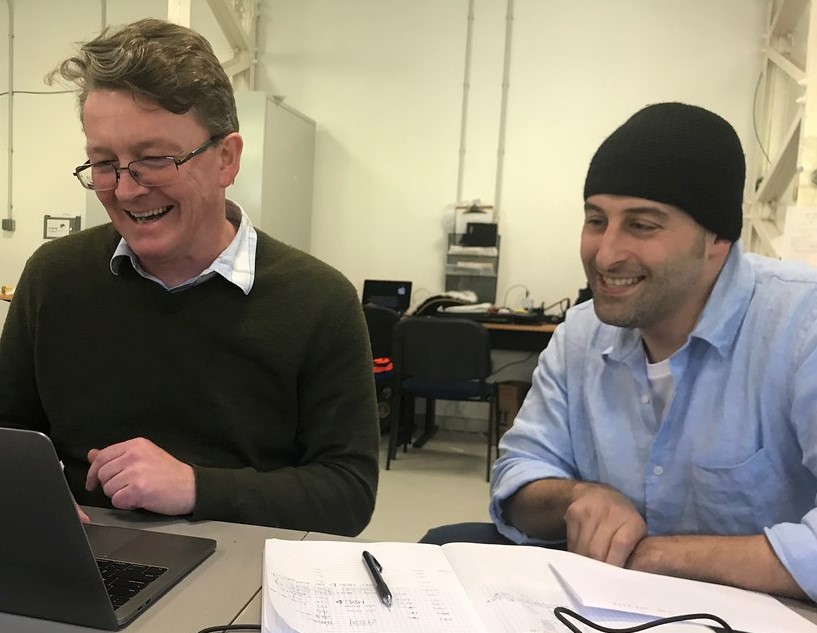
Another example in Wood’s list of studies related to ACE-ENA is a December 2020 paper led by Christine Chiu of Colorado State University. With a boost from machine learning, the study delivers insights into autoconversion, a key process influencing drizzle and precipitation in boundary layer clouds. (One of Wood’s earliest papers, published in 2000, looked at drizzle, and it has remained an interest.)
Autoconversion, a water-coalescence process in clouds, is the rate at which cloud droplets collide and stick together to form drizzle.
Accurately simulating it is important. Autoconversion is a key process in climate model predictions of surface temperatures affected by the sensitivity of cloud solar reflectivity to aerosol.
Chiu’s study “is something I was very pleased to be involved in,” says Wood, including its use of machine learning, which “alludes to where the future is. That’s the new frontier for a lot of research data.”
Campaigns in Synergy
Beyond ACE-ENA, Wood devoted a lot of additional effort to aerosol-cloud-radiation issues in the southeast Atlantic Ocean basin, home to the world’s largest decks of subtropical stratocumulus clouds.
Starting in 2015, he was the deputy principal investigator of a five-year NASA air campaign called ObseRvations of Aerosols above Clouds and their intEractionS (ORACLES), based in Namibia. ORACLES included three periods of intensive observations (in 2016, 2017, and 2018) to study the climate effects of biomass burning aerosol particles that seasonally stream into and above the regional cloud cover.
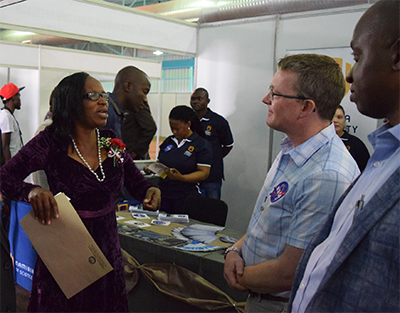
In 2016, Wood joined other ORACLES scientists, air crew, and staff in education outreach in Namibia. It was a whirlwind of interviews, lectures, open houses at the Walvis Bay airfield, and a three-day visit to the Ongwediva Annual Trade Fair in northern Namibia.
ORACLES put Wood and other scientists into a confluent, co-located web of international efforts with roughly the same science mission.
Joining ORACLES in a look at smoke-aerosol-cloud evolution was ARM’s 2016―2017 Layered Atlantic Smoke Interactions with Clouds (LASIC) field campaign; Cloud-Aerosol-Radiation Interactions and Forcing―17 (CLARIFY―17), a British airborne research project based on Ascension Island; and a 2016―2019 French airborne effort called Aerosol Radiation in Clouds in Southern Africa (AEROCLO-sA), based at Walvis Bay, Namibia.
All four campaigns overlapped during August and September 2017. They represent a unique synergism, which prompted a joint data workshop in April 2019 in Paris. (Another was planned but has been delayed by the COVID pandemic.)
“They were well-connected projects,” says Wood, and will inform papers for some time. “Campaigns tend to take several years before the results are exhausted.”
Bright Ideas
In his university work, Wood has cast a wide net of inquiries into clouds, climate, and weather.
For one, he is principal investigator for the Marine Cloud Brightening Project, a multidisciplinary international research group investigating ways to increase how much sunlight clouds reflect―that is, how to boost their cooling effect. If such an intervention were possible (it’s not, yet), it could potentially reduce the environmental impacts of global warming.
In 2015, the National Academies Press published a report on strategies for solar climate intervention, including ways to brighten low-lying marine clouds by altering the particles within them. (Wood was a reviewer.)
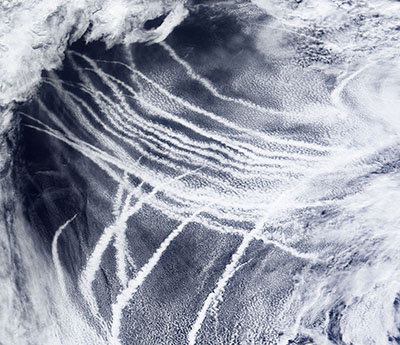
The lengthy 2015 report was briefly updated in March 2021 and touched on cloud-based cooling strategies that include cloud brightening, aerosol injections, and cirrus cloud thinning. At the same follow-up report, the authors recommended establishing a national solar geoengineering research program that encompasses impacts and technical dimensions of research as well as characterizing the context and goals of solar geoengineering and social dimensions including governance and ethics.
“It’s an intriguing idea―to be able to introduce a perturbation into clouds” that makes them more reflective, says Wood.
One proposed scheme would deploy ocean-going ships to deliver sea salt spray into the atmosphere. In theory, that could brighten affected clouds by 5% to 7%. Applied to a significant fraction of marine clouds worldwide, some say, could offset warming by as much as 2 degrees Celsius.
Of course, controlled experiments “are something we cannot currently do,” Wood says.
But he pointed to a 2020 paper by cloud-brightening researchers that outlines a natural experiment that could be a proxy for a cloud-perturbing controlled experiment: oceanic “ship tracks,” which are contrail-like clouds left by ships along major shipping lanes because of their smokestack emissions.
“For the first time,” write the authors (Wood among them), “we observe a substantial increase in cloud brightness by shipping on a regional scale.”
Wood was sole author of a more recent paper on marine cloud brightening, published in October 2021. It demonstrates a model of the potential efficacy of a hypothetical scheme involving ship-borne sprayers that inject salt particles below marine low clouds. The idea is to augment aerosols linked to higher cloud albedo (brightness) and higher cloud-droplet reflectivity.
Intentional cloud brightening is a controversial idea, Wood admits. “But we ought to know what is possible.”
Getting There
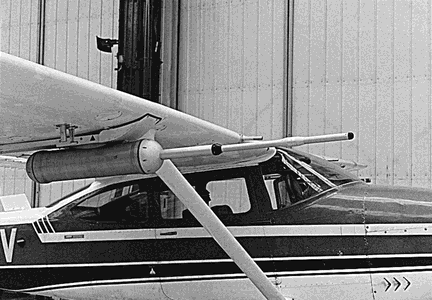
Getting to where Wood is today required, among other things, a pair of singed eyebrows (his own), a bit of seismic movement in the Earth’s crust (in theory, at least), and a couple hundred hours in a single-engine plane. The pilot cautioned, Wood remembers, “Always look for a place to land.”
The story of the eyebrows: Think of a boy in England’s suburban Manchester with a chemistry set.
Oops.
“I was fascinated by chemical transformations,” explains Wood. (His father, an academic in government, and his mother, a magistrate, respectively, took their son’s experiments in stride, along with his longtime fascination with trains.)
The seismic activity: OK. In a book, maybe. He was at the University of Cambridge (B.A. Natural Sciences, 1992), wrapping up studies in physics and theoretical physics, when a course in geophysics caught his heart off guard.
Tracking seismic activity introduced Wood to remote sensing. His attraction to getting data from remotely sited ground, air, and satellite instruments stands to this day.
Wood remembers thinking: “Oh, you can study things outside,” he says. “The geophysics class I did in my final year was the game changer for me.”
Sea Breezes
Wood’s new fascination with remote sensing helped propel Wood to a doctoral program in atmospheric physics at the University of Manchester Institute of Science and Technology (PhD, 1997).
He studied with mentor Peter Jonas, who was interested in the radiative effects of clouds and the efficacy of airborne research.
Before long, Wood veered from the Jonas group’s focus on clouds to join a Jonas side project on the dynamics of sea breezes. For about 250 hours over two years, at about two hours a flight, he took to the skies aboard a university-owned Cessna 182 light aircraft.
With a few instruments squeezed into the snug cockpit, Wood and his pilot flew transects in eastern England, back and forth to the seaside over the region’s relatively flat terrain. Attached to the underside of the right-hand wing was a five-hole probe designed to measure the wind vector relative to the aircraft.
When land heats up during the day, Wood explains, it warms faster than the nearby ocean. That temperature disparity prompts inshore wind flows―sea breezes, which can move inland 100 kilometers (62 miles) or more. These wedges of cold air often behave like cold fronts and sometimes initiate thunderstorms.
“The dynamics of this is important,” says Wood.
He turned his data on sea breezes into a dissertation on the structure of the boundary layer enabled by airborne observations in a light aircraft. The work is reflected in his first published paper, in 1997, which describes a low-cost system for optimizing air-motion measurements.
Wood, so far, has written 155 peer-reviewed publications. Of his first 15 papers, 13 mention aircraft data or campaigns in the titles.
Hello, Satellites
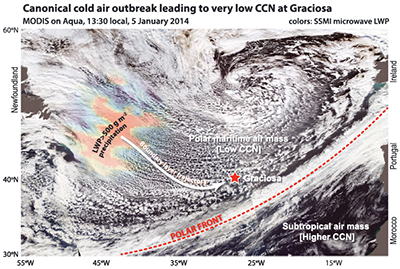
Wood went next to the United Kingdom’s Meteorological Office, signing on as a research scientist with the cloud microphysics group from 1997 to 2001.
The Met Office, as it’s called, had a C-130 research aircraft in those days, “and I got in a lot of flight hours,” says Wood.
In 2001, on the eve of the Met Office losing its aircraft during a transition to another, Wood took advantage of an unpaid leave program and decamped to the University of Washington as a postdoctoral researcher.
That turned into a deep dive on studying clouds from a satellite perspective. Wood immersed himself in NASA’s Earth Observing System Data and Information System, as well as readings from space-borne NASA instruments. Those included the Moderate Resolution Imaging Spectroradiometer (MODIS), a data-image sensor aboard the NASA Aqua satellite he still uses today. Every one or two days, with a sweep 2,330 kilometers (1,450 miles) wide, MODIS snaps images of every point on Earth in 36 spectral bands.
A figure from a December 2016 paper that Wood led shows a composite of three MODIS images from the NASA Aqua satellite.
During those postdoctoral days, Wood had help from veteran researchers.
Atmospheric scientist Christopher Bretherton, an expert on cloud formation and turbulence, “brought me into cloud-scale modeling,” he says.
And aerosol-science pioneer Robert Charlson, a professor emeritus of atmospheric chemistry by the time Wood arrived in Seattle, “convinced me to get into lidar and to look at aerosol layers above and near clouds,” he says―the start of an interest that led to study of aerosol layers over the South Atlantic that later inspired his role in LASIC and ORACLES. (Charlson died in September 2021.)
After just 18 months of his Pacific Northwest interlude, says Wood of returning to England, “I did not want to go back.”
Back in the Air
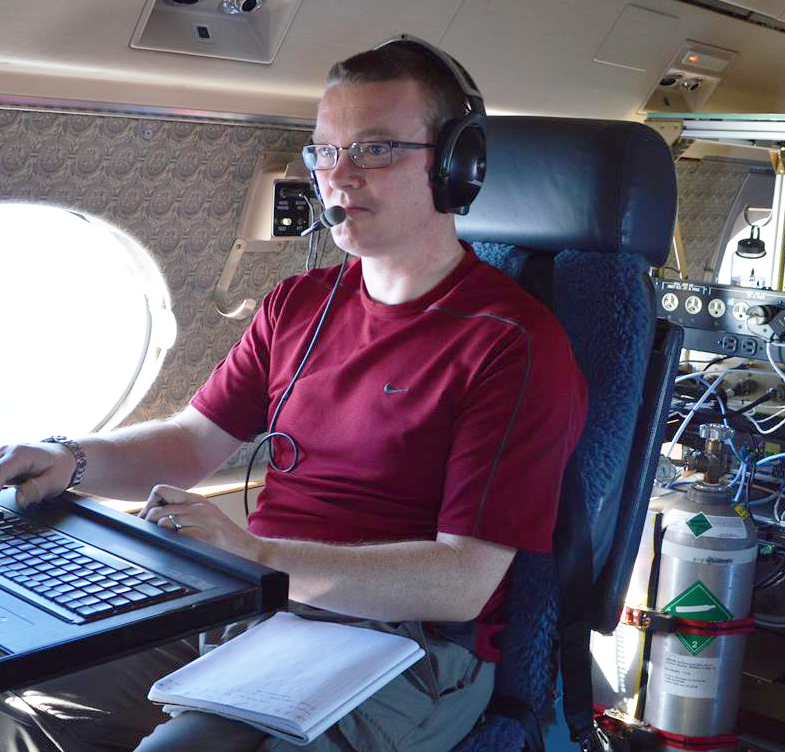
In 2003, right around the time Wood had his first contact with ARM and the predecessor of ASR, he signed on at the University of Washington in a more permanent way, becoming a research assistant professor. It was a license to delve further into the business of cloud physical processes.
Amid a steady stream of papers since then, Wood ascended through the academic ranks, becoming a professor in 2014 and associate dean for research from 2017 to 2020. He wrote widely, including about the spectral ripening effect, autoconversion, the boundary layer, midlatitude cyclones, marine open-cell clouds, satellite views of aerosols, warm rain, and African biomass burning.
Wood also got back into the air as a researcher. He took part in the VAMOS Ocean-Cloud-Atmosphere-Land Study Regional Experiment (VOCALS-REx), an air and sea field campaign off the coast of northern Chile, which included an intensive period of observation in the fall of 2008. (VAMOS stands for Variability of the American Monsoon Systems, part of the Climate and Ocean: Variability, Predictability, and Change projects funded by the World Climate Research Programme.)
Five aircraft, including ARM’s Gulfstream-159 (G-1) aircraft, took part in VOCALS-Rex. So did two ships. The campaign was designed in part to observe aerosols, clouds, and precipitation in the southeast Pacific Ocean, home to the largest subtropical stratocumulus cloud deck on Earth.
Then came CAP-MBL in 2009 and 2010, a 21-month ARM Mobile Facility (AMF) field campaign centered on clouds, aerosols, and precipitation in the marine boundary layer around Graciosa Island. Operating the AMF there eventually led to the development of the fixed ARM ENA site on the island.
Wood was also part of the 2015 Cloud Systems Evolution in the Trades (CSET) campaign, which involved air hours aboard a Gulfstream V (GV) research aircraft maintained by the National Center for Atmospheric Research. Researchers were looking at clouds, aerosols, precipitation, and turbulence in the northern Pacific during flights between California and Hawaii.
From there, starting in 2015, it was a smooth transition to ORACLES and its airborne data-gathering.
“I keep returning to research aircraft campaigns,” says Wood. “They provide some key measurements that are only possible by actually being inside the clouds themselves.”
Cooking, Singing
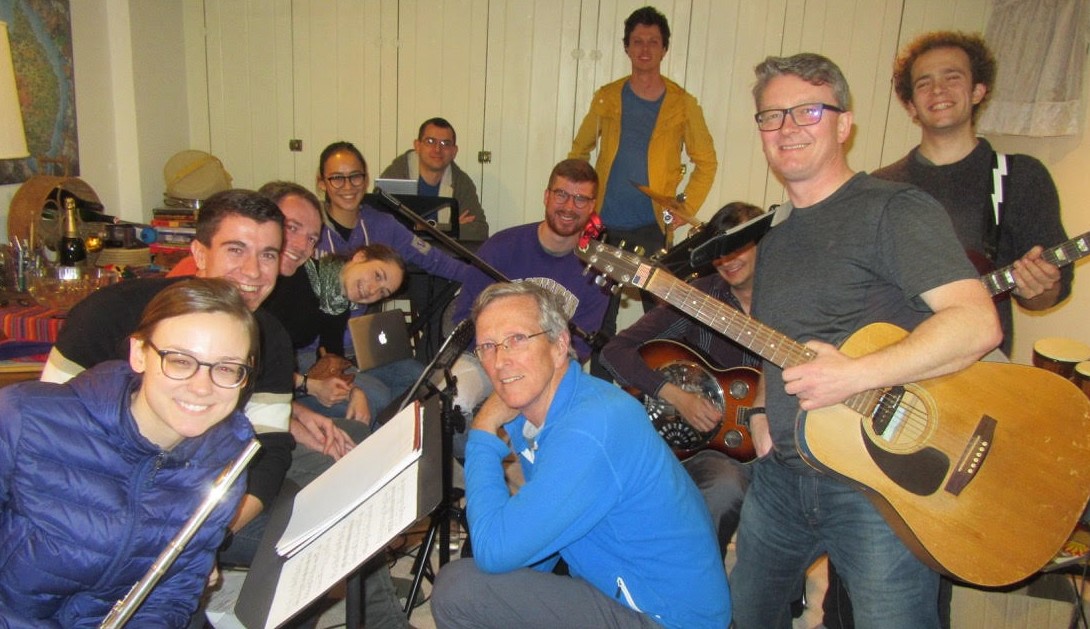
Life can’t all be about the marine boundary layer and the mysteries bound up in low clouds.
“I do value time outside work,” says Wood, who is co-parenting an 11-year-old daughter.
For the two of them, and his girlfriend, Wood likes to cook at home, a longtime avocation.
He also plays the guitar and sings, a pastime that in most years puts him in company with the Atmospherics. That’s a pop-up band at the University of Washington that usually gathers in December for some in-tune holiday cheer.
“We practice five or six times,” says Wood, then usually put on a department show featuring songs that have atmospheric science themes. The band covers originals (“Rain,” by the Beatles, for instance) and writes lyrics set to familiar melodies.
The only evidence on YouTube that the Atmospherics exist dates to 2015. One song was about―gulp―the Bergeron-Findeisen theory of raindrop growth in clouds.
Another, “No Rain,” was about drought. (“If you’re in the Southwest, after the fossil fuel fest―no rain,” set to the tune of Eric Clapton’s “Cocaine.”) Condensation got star billing in one song. Another took a good-natured poke at meteorologists on television.
When you’re frustrated with the way things are, said Wood during the 2015 show, “you can do other things.”
# # #Author: Corydon Ireland, Science Writer, Pacific Northwest National Laboratory
This work was supported by the U.S. Department of Energy’s Office of Science, through the Biological and Environmental Research program as part of the Atmospheric System Research program.

